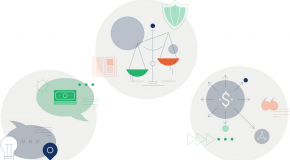Bridging the skills gap in procurement
The growing skills gap is a critical challenge for the future of procurement, according to research by Economist Impact.
18339
Related content

Steering through collaboration: CFOs driving new priorities for the future
It is well established that the modern CFO has a more strategic role to play in a business, but a clear action plan to achieve this is lacking. A key element of this is helping the business to deal with change. Some changes are planned: launching a new product or service, setting up operations in a new region or acquiring a competitor. Others may be unexpected: a major disruption to supply-chain operations, the emergence of new regulation and legal reporting requirements or the unpredictable impacts of global economic uncertainty.
Either way, when asked about the biggest challenges they face in executing their day-to-day activities, change is a recurring theme, according to a new survey of 800 CFOs and senior finance executives, conducted by The Economist Intelligence Unit. Managing unexpected changes to financial forecasts and adapting finance processes to rapidly evolving business models are top of mind.
Managing unexpected changes to financial forecasts and adapting finance processes to rapidly evolving business models are top challenges finance executives face in executing their day to-day activities.
Finance executives are also concerned with identifying how to align strategic, financial and operational plans towards common objectives and meaningfully analysing data across business units and regions. “All functions are working to meet these challenges and, as a finance head, we have to have visibility across all functions, how they are progressing [towards meeting goals] and ensuring that their direction is in line with overall strategic goals,” says Lalit Malik, CFO of Dabur, an Indian consumer goods manufacturer. It is incumbent upon CFOs therefore to be prepared not only to help their own function navigate uncharted territory, but the rest of the business too. That means breaking down the silos that commonly exist in organisations, in order to collaborate closely across functions, sharing information and data in the pursuit of common objectives.
All functions are working to meet these challenges and, as a finance head, we have to have visibility across all functions, how they are progressing [towards meeting goals] and ensuring that their direction is in line with overall strategic goals - Lalit Malik, CFO of Dabur, an Indian consumer goods manufacturer.
The clear custodian of collaboration
There are a number of reasons why the role of leading cross-company collaboration around steering should fall to the CFO and their team. First, through the activities of budgeting, the finance function is the custodian of the clear, quantitative expression of management expectations and determines how resources such as cash and people will be allocated in order to achieve them. In our survey, 90% of respondents say that finance should facilitate collaborative enterprise planning to ensure that operational plans are aligned with financial and strategic plans.
Second, through performance management, the finance function is the gatekeeper for critical data that illustrate how well—or otherwise—the company is rising to the challenge of change. That includes data relating to sales, supply chain and delivery, which need to be reported back to the business in ways that help drive improved decisionmaking. Our survey reveals that companies in which finance executives feel empowered to drive strategic decisions across business functions are more likely to report a higher financial performance in fiscal year 2016/17 and 2017/18 and anticipate higher growth rates for 2019/20.
Download Complete Executive Summary PDF

Transforming data into action
As businesses generate and manage vast amounts of data, companies have more opportunities to gather data, incorporate insights into business strategy and continuously expand access to data across the organisation. Doing so effectively—leveraging data for strategic objectives—is often easier said than done, however. This report, Transforming data into action: the business outlook for data governance, explores the business contributions of data governance at organisations globally and across industries, the challenges faced in creating useful data governance policies and the opportunities to improve such programmes. Learn more by downloading our whitepaper below.

Rethinking professional services in an age of disruption
AI demands a new era of procurement skills
AI tools are already helping procurement professionals at 64% of firms, according to research by Economist Impact
Artificial intelligence (AI) is rapidly transforming the procurement landscape, redefining roles and reshaping how organizations approach their procurement teams. According to an Economist Impact research program, sponsored by Amazon Business, organizations are amid a pivotal shift, as companies increasingly leverage AI to enhance efficiency and drive strategic decision-making.
18338
Related content

Steering through collaboration: CFOs driving new priorities for the future
It is well established that the modern CFO has a more strategic role to play in a business, but a clear action plan to achieve this is lacking. A key element of this is helping the business to deal with change. Some changes are planned: launching a new product or service, setting up operations in a new region or acquiring a competitor. Others may be unexpected: a major disruption to supply-chain operations, the emergence of new regulation and legal reporting requirements or the unpredictable impacts of global economic uncertainty.
Either way, when asked about the biggest challenges they face in executing their day-to-day activities, change is a recurring theme, according to a new survey of 800 CFOs and senior finance executives, conducted by The Economist Intelligence Unit. Managing unexpected changes to financial forecasts and adapting finance processes to rapidly evolving business models are top of mind.
Managing unexpected changes to financial forecasts and adapting finance processes to rapidly evolving business models are top challenges finance executives face in executing their day to-day activities.
Finance executives are also concerned with identifying how to align strategic, financial and operational plans towards common objectives and meaningfully analysing data across business units and regions. “All functions are working to meet these challenges and, as a finance head, we have to have visibility across all functions, how they are progressing [towards meeting goals] and ensuring that their direction is in line with overall strategic goals,” says Lalit Malik, CFO of Dabur, an Indian consumer goods manufacturer. It is incumbent upon CFOs therefore to be prepared not only to help their own function navigate uncharted territory, but the rest of the business too. That means breaking down the silos that commonly exist in organisations, in order to collaborate closely across functions, sharing information and data in the pursuit of common objectives.
All functions are working to meet these challenges and, as a finance head, we have to have visibility across all functions, how they are progressing [towards meeting goals] and ensuring that their direction is in line with overall strategic goals - Lalit Malik, CFO of Dabur, an Indian consumer goods manufacturer.
The clear custodian of collaboration
There are a number of reasons why the role of leading cross-company collaboration around steering should fall to the CFO and their team. First, through the activities of budgeting, the finance function is the custodian of the clear, quantitative expression of management expectations and determines how resources such as cash and people will be allocated in order to achieve them. In our survey, 90% of respondents say that finance should facilitate collaborative enterprise planning to ensure that operational plans are aligned with financial and strategic plans.
Second, through performance management, the finance function is the gatekeeper for critical data that illustrate how well—or otherwise—the company is rising to the challenge of change. That includes data relating to sales, supply chain and delivery, which need to be reported back to the business in ways that help drive improved decisionmaking. Our survey reveals that companies in which finance executives feel empowered to drive strategic decisions across business functions are more likely to report a higher financial performance in fiscal year 2016/17 and 2017/18 and anticipate higher growth rates for 2019/20.
Download Complete Executive Summary PDF

Transforming data into action
As businesses generate and manage vast amounts of data, companies have more opportunities to gather data, incorporate insights into business strategy and continuously expand access to data across the organisation. Doing so effectively—leveraging data for strategic objectives—is often easier said than done, however. This report, Transforming data into action: the business outlook for data governance, explores the business contributions of data governance at organisations globally and across industries, the challenges faced in creating useful data governance policies and the opportunities to improve such programmes. Learn more by downloading our whitepaper below.

Rethinking professional services in an age of disruption
Turbulent waters, trusted anchors: the general counsel’s evolving role in navigating crises
Crisis events are more frequent, severe and unpredictable than ever. For businesses, being un- or under-prepared for myriad crisis scenarios is also costlier than ever. The perils that confront them range from temporary paralysis of operations, to permanent business closures to adverse impacts that ripple through the broader economy. Beyond protecting enterprises from the worst impacts of crisis events, robust crisis preparedness also comes with a promise of growing and supporting bottom lines further. Moreover, all crises have deep reputational implications.
18316
Related content

Steering through collaboration: CFOs driving new priorities for the future
It is well established that the modern CFO has a more strategic role to play in a business, but a clear action plan to achieve this is lacking. A key element of this is helping the business to deal with change. Some changes are planned: launching a new product or service, setting up operations in a new region or acquiring a competitor. Others may be unexpected: a major disruption to supply-chain operations, the emergence of new regulation and legal reporting requirements or the unpredictable impacts of global economic uncertainty.
Either way, when asked about the biggest challenges they face in executing their day-to-day activities, change is a recurring theme, according to a new survey of 800 CFOs and senior finance executives, conducted by The Economist Intelligence Unit. Managing unexpected changes to financial forecasts and adapting finance processes to rapidly evolving business models are top of mind.
Managing unexpected changes to financial forecasts and adapting finance processes to rapidly evolving business models are top challenges finance executives face in executing their day to-day activities.
Finance executives are also concerned with identifying how to align strategic, financial and operational plans towards common objectives and meaningfully analysing data across business units and regions. “All functions are working to meet these challenges and, as a finance head, we have to have visibility across all functions, how they are progressing [towards meeting goals] and ensuring that their direction is in line with overall strategic goals,” says Lalit Malik, CFO of Dabur, an Indian consumer goods manufacturer. It is incumbent upon CFOs therefore to be prepared not only to help their own function navigate uncharted territory, but the rest of the business too. That means breaking down the silos that commonly exist in organisations, in order to collaborate closely across functions, sharing information and data in the pursuit of common objectives.
All functions are working to meet these challenges and, as a finance head, we have to have visibility across all functions, how they are progressing [towards meeting goals] and ensuring that their direction is in line with overall strategic goals - Lalit Malik, CFO of Dabur, an Indian consumer goods manufacturer.
The clear custodian of collaboration
There are a number of reasons why the role of leading cross-company collaboration around steering should fall to the CFO and their team. First, through the activities of budgeting, the finance function is the custodian of the clear, quantitative expression of management expectations and determines how resources such as cash and people will be allocated in order to achieve them. In our survey, 90% of respondents say that finance should facilitate collaborative enterprise planning to ensure that operational plans are aligned with financial and strategic plans.
Second, through performance management, the finance function is the gatekeeper for critical data that illustrate how well—or otherwise—the company is rising to the challenge of change. That includes data relating to sales, supply chain and delivery, which need to be reported back to the business in ways that help drive improved decisionmaking. Our survey reveals that companies in which finance executives feel empowered to drive strategic decisions across business functions are more likely to report a higher financial performance in fiscal year 2016/17 and 2017/18 and anticipate higher growth rates for 2019/20.
Download Complete Executive Summary PDF

Transforming data into action
As businesses generate and manage vast amounts of data, companies have more opportunities to gather data, incorporate insights into business strategy and continuously expand access to data across the organisation. Doing so effectively—leveraging data for strategic objectives—is often easier said than done, however. This report, Transforming data into action: the business outlook for data governance, explores the business contributions of data governance at organisations globally and across industries, the challenges faced in creating useful data governance policies and the opportunities to improve such programmes. Learn more by downloading our whitepaper below.

Rethinking professional services in an age of disruption
What we are watching: top trends for 2024
Related content

Steering through collaboration: CFOs driving new priorities for the future
It is well established that the modern CFO has a more strategic role to play in a business, but a clear action plan to achieve this is lacking. A key element of this is helping the business to deal with change. Some changes are planned: launching a new product or service, setting up operations in a new region or acquiring a competitor. Others may be unexpected: a major disruption to supply-chain operations, the emergence of new regulation and legal reporting requirements or the unpredictable impacts of global economic uncertainty.
Either way, when asked about the biggest challenges they face in executing their day-to-day activities, change is a recurring theme, according to a new survey of 800 CFOs and senior finance executives, conducted by The Economist Intelligence Unit. Managing unexpected changes to financial forecasts and adapting finance processes to rapidly evolving business models are top of mind.
Managing unexpected changes to financial forecasts and adapting finance processes to rapidly evolving business models are top challenges finance executives face in executing their day to-day activities.
Finance executives are also concerned with identifying how to align strategic, financial and operational plans towards common objectives and meaningfully analysing data across business units and regions. “All functions are working to meet these challenges and, as a finance head, we have to have visibility across all functions, how they are progressing [towards meeting goals] and ensuring that their direction is in line with overall strategic goals,” says Lalit Malik, CFO of Dabur, an Indian consumer goods manufacturer. It is incumbent upon CFOs therefore to be prepared not only to help their own function navigate uncharted territory, but the rest of the business too. That means breaking down the silos that commonly exist in organisations, in order to collaborate closely across functions, sharing information and data in the pursuit of common objectives.
All functions are working to meet these challenges and, as a finance head, we have to have visibility across all functions, how they are progressing [towards meeting goals] and ensuring that their direction is in line with overall strategic goals - Lalit Malik, CFO of Dabur, an Indian consumer goods manufacturer.
The clear custodian of collaboration
There are a number of reasons why the role of leading cross-company collaboration around steering should fall to the CFO and their team. First, through the activities of budgeting, the finance function is the custodian of the clear, quantitative expression of management expectations and determines how resources such as cash and people will be allocated in order to achieve them. In our survey, 90% of respondents say that finance should facilitate collaborative enterprise planning to ensure that operational plans are aligned with financial and strategic plans.
Second, through performance management, the finance function is the gatekeeper for critical data that illustrate how well—or otherwise—the company is rising to the challenge of change. That includes data relating to sales, supply chain and delivery, which need to be reported back to the business in ways that help drive improved decisionmaking. Our survey reveals that companies in which finance executives feel empowered to drive strategic decisions across business functions are more likely to report a higher financial performance in fiscal year 2016/17 and 2017/18 and anticipate higher growth rates for 2019/20.
Download Complete Executive Summary PDF

Transforming data into action
As businesses generate and manage vast amounts of data, companies have more opportunities to gather data, incorporate insights into business strategy and continuously expand access to data across the organisation. Doing so effectively—leveraging data for strategic objectives—is often easier said than done, however. This report, Transforming data into action: the business outlook for data governance, explores the business contributions of data governance at organisations globally and across industries, the challenges faced in creating useful data governance policies and the opportunities to improve such programmes. Learn more by downloading our whitepaper below.

Rethinking professional services in an age of disruption
Bridging the skills gap: fuelling careers and the economy in Asia-Pacific
The nature of jobs and skills requirements are changing rapidly across the Asia-Pacific region (APAC). The fast pace of transformation is forcing business leaders to quickly identify looming skills gaps and prepare their workforces for the future, giving clear direction to employees on how to build the skills they will need to thrive. Getting ahead of these skills gaps will require investment, leadership, and clear communication about the effects of trends like digitisation and automation on future skills needs.
Related content

Bridging the skills gap: Fuelling careers and the economy in Indonesia
Economist Impact, supported by Google, conducted a survey of 1,375 employees across Asia-Pacific (APAC), including 100 employees from Indonesia, between November 2022 and January 2023. It also interviewed employers and industry experts across the region to understand their perspectives on skills gaps, as well as reskilling and upskilling aspirations.
The survey respondents were drawn from across 14 markets in the region, out of which 11.8% were Gen Z (born in 1997-2012), 63.2% were Millennials (1981-96) and 25% were Gen X (1965-80). They all worked in a diverse mix of industries.
The research shows that across the region, common understanding is lacking between employers and employees about future skills and the best way to develop them. In some instances, there is also an expectation mismatch between what employers want and what employees see as being important. Understanding these gaps will be instrumental in creating a workforce that is prepared for the economy of the future.
This article—one in a series of 12 market reports—examines these issues in Indonesia. This series complements a research paper that looks at the reskilling and upskilling imperative across APAC.
Key findings
Indonesian employees consider digital skills (60%) the top focus area for upskilling. Among these, basic digital skills are foundational for 88.3% of Indonesian workers. As digitalisation spreads across the archipelago, the country will increasingly demand more advanced skills. Employees consider capabilities with data analysis and visualisation (56.7%), IT support (51.7%), and digital marketing and e-commerce (48.3%) as the most important advanced tech skills to have. Workers have the highest expectations for their employers, believing they should support their development by providing information on skills (57%), through financial incentives (54%), recognition (43%) and supporting their mental well-being (35%).Indonesia is one of Southeast Asia’s fastest-growing internet economy. Between 2015 and 2019, its technology sector grew at an average rate of 49% a year, alongside rapid e-commerce adoption by both large and small businesses.1 The economy’s digitalisation has enabled many in the workforce, especially the young, to participate as freelancers, particularly in the transportation and delivery sectors.2
However, many have been left out due to uneven internet connectivity and low literacy rates. For instance, most internet users tend to be concentrated in urban centres and are young—only 21% are over 50 years old.3 The issues are not just limited to the older population, as almost a quarter of young people (22.5%) in Indonesia are not in education, employment or training4 and the World Bank estimates that only 19% of 25-34 year olds had a tertiary qualification in 2021, much lower than the global average of 47%.5
The future of Indonesia’s economy is digital
Most Indonesian employees (60%) consider digital skills the most important to acquire. This is in sync with the digitalisation underway in the economy — Indonesia’s digitally skilled workers are forecast to contribute US$303.4bn to its GDP by 2030, accounting for 16% of GDP.6
Government analysis shows that the expanding technology sector could create 20m-45m new jobs in Indonesia.7 Between 2019 and 2030, non-tech sectors such as professional services, manufacturing and construction — are expected to see the highest growth in GDP contributions from digitally skilled workers, as these sectors increasingly adopt technology to improve their productivity.8
Figure 1: Digital skills are a top priority for Indonesian employees
Which skill categories do you think are the most important for the workforce in your sector to acquire today? (%)
Source: Economist Impact, 2023
Within the broad category of digital skills, employees in our survey consider advanced digital skills such as data analysis and visualisation (56.7%), IT support (51.7%), and digital marketing and e-commerce (48.3%) as must-have skills. Employees also said the same for coding and programming (26.7%) and artificial intelligence (AI) and machine learning (25%). The importance given to these advanced skills possibly reflects a skills gap, as data from 2020 suggest that less than 1% of the workforce in the country possessed advanced digital skills.9
Advanced digital skills are becoming more important for various sectors too. For instance, big data analytics skills are increasingly used in the banking sector to understand customers’ spending patterns and preferences, to cross-sell products and for fraud management.10 Similarly, AI is expected to improve care delivery and hospital operations.11 Meanwhile, farmers are benefitting in myriad ways from real-time monitoring and prediction systems with Internet of Things-enabled tools.12
Cybersecurity is another must-have advanced digital skill for 36.7% of employees, reflecting Indonesia’s struggles with digital risks. The country was ranked the most vulnerable in Southeast Asia for cyber risks, and faced more than 11m attacks in the first quarter of 2022 alone.13
Although green skills such as sustainability reporting, sustainable business management and supply chain management are considered less important at present(15%), these skills would gain importance due to the country's rising sustainability concerns. Indonesia is ranked among the top countries exposed to climate risks with high vulnerability to all types of flooding and extreme heat. 14
Figure 2: Advanced digital skills such as data analysis and visualisation, and IT support are must-haves
Indicate which specific types of digital skills are must-have, good to have or not needed for the workforce in your sector today (%)
Source: Economist Impact, 2023
Infrastructure and high costs complicate access to skilling
Employees in Indonesia are strongly motivated to acquire new skills. Nearly half (49%) of the employees agree that upskilling or reskilling has had a high impact in improving performance in their current roles, and 54% report a high impact in exploring new roles and areas of interest. Despite these motivations, more than one in four (27%) employees cite poor internet access as a barrier in acquiring new digital skills. Nila Marita, director and head of external affairs at GoTo—the holding company of two major Indonesian startups, Gojek and Tokopedia—agrees that internet connectivity is “crucial to increase access to important learning opportunities in Indonesia and bridging this gap will enable more Indonesians to acquire digital skills.” Addressing access is important, as employees utilise online courses for learning. Indeed, 54% of employees say they obtain digital skills outside of the workplace via online courses.
High costs (42%) are also a major hurdle in Indonesians’ ability to digitally upskill, and companies are not investing enough to provide workers with on-the-job training.15 Additionally, Indonesia has a large, informal sector made up of low-income workers, creating challenges for employees to afford skilling programmes and for the government to reach them.16 17
Figure 3: Key skilling obstacles for employees across skills types
What are the top three significant obstacles that you face while learning new skills?
Source: Economist Impact, 2023
Another challenge that employees cite across most skill sets is a lack of time in learning new courses. Indonesian workers have reported experiencing higher workload after the Covid-19 pandemic.18 This also aligns with the higher importance that employees in our survey assign to self-management skills like time management, resilience and stress tolerance (49%).
High expectations from employers
According to our survey respondents, employers are the most responsible for supporting their development across every category apart from providing access to diversified skilling programmes. In particular, they see their employers as a key source of providing information on skills (57%), financial incentives (54%), recognition (43%) and support for their mental well-being (35%).
Employers could address many of the obstacles that employees face such as high costs and time restrictions by subsidising access to training programmes and integrating more workplace training sessions. “Both the government and private sector in Indonesia have been scaling up efforts to develop the country’s talent pool in recent years,” says Ms Marita from GoTo. For instance, organisations and the government are increasingly collaborating with universities to prepare university students with in-demand skills. Private sector companies are also training the trainers and working together with them to design the curriculum based on companies’ skills needs.
Figure 4: Employers are considered the most responsible for upskilling Indonesians
In your opinion who is responsible for supporting employees regarding the following issues? (%)
Source: Economist Impact, 2023
Seventy-seven percent of employees, substantially higher than the regional average (66.5%), believe that employers now lean towards skills-based hiring over paper qualifications. In this context, efforts by government, educational institutions and companies to communicate what skills are in-demand will help the workforce prioritise which ones to learn. While most workers rely on social media and advertisements (73%) for information on valuable skills, government awareness programmes are also an important source for 50% of employees.
Multi-stakeholder collaboration key to closing skills gaps
Overcoming access and infrastructure gaps is integral to realising Indonesia’s digital economic potential. The government has made efforts to counteract these issues through various programmes such as Kartu Prakerja, an online upskilling programme targeted at retraining one million unemployed and low-income adults who are 18-64 years old.19 20 The programme takes an end-to-end approach, providing access to upskilling and reskilling subsidies, courses and job vacancies. Subsidies can also be useful in driving the uptake of green skills, which acts as the biggest motivation to acquire these skills for one in three surveyed employees. Another programme provided by Indonesia’s Ministry of Communications and Information is the Digital Talent Scholarship (DTS). It aims to develop the skills and competitiveness of the country’s workforce in the information and communication technology sector.21
For Indonesia to fully unlock the economic potential of digital skilling, it must extend this kind of opportunity to workers at micro, small and medium enterprises which employ 97% of the country’s workforce.22
Another government programme is Making Indonesia 4.0, a roadmap launched in 2018 to accelerate digitalisation.23 Elements of this roadmap are geared towards training and reskilling workers as technology becomes more ingrained in industrial processes. Additionally, attempts to broaden equitable access to digital skilling opportunities could close the skills gaps.
References
1 https://digitalcfoasia.com/2023/01/10/addressing-the-critical-skill-gaps-in-indonesia/
2 https://fair.work/wp-content/uploads/sites/17/2021/12/Fairwork-Report-Indonesia-2021-accessible.pdf
3 https://smeru.or.id/en/publication/diagnostic-report-digital-skills-landscape-indonesia
4 https://data.worldbank.org/indicator/SL.UEM.NEET.ZS?locations=ID
5 https://gpseducation.oecd.org/CountryProfile?primaryCountry=IDN&treshold=5&topic=EO
6 https://accesspartnership.com/wp-content/uploads/2023/03/skills-for-the-future-executive-summary-in-english.pdf
7 https://opengovasia.com/creating-million-new-jobs-through-digital-technology-in-indonesia/
8 https://accesspartnership.com/wp-content/uploads/2023/03/skills-for-the-future-executive-summary-in-english.pdf
9 https://pathwayscommission.bsg.ox.ac.uk/sites/default/files/2022-03/FINAL_Diagnostic%20Report_Accessible.pdf
10 https://www.sciencedirect.com/science/article/pii/S1877050915005992
11 https://www.usa.philips.com/healthcare/nobounds/phoenix-childrens-benefits-of-ai-in-healthcare#_continue-reading
12 https://www.xcubelabs.com/blog/benefits-of-iot-in-agriculture-and-smart-farming/
13 https://en.antaranews.com/news/227061/indonesia-faces-11-mln-cyber-attacks-in-2022-first-quarter
14 https://www.adb.org/sites/default/files/publication/700411/climate-risk-country-profile-indonesia.pdf
15 https://www.weforum.org/agenda/2022/11/indonesia-edtech-financial-inclusion/
16 An informal economy broadly refers to any part of the economy that is unregistered, meaning that they are not covered or are insufficiently covered by formal employment arrangements. In most of these cases, companies remain largely unaccountable to any regulation as workers are not officially classed as employees, limiting their access to government services, including welfare, labour rights protections and public programmes. In Indonesia, 60% of the workforce is employed by the informal sector and accounts for 22.7% of national GDP (US$776 billion).
17 https://www.ilo.org/jakarta/areasofwork/informal-economy/lang--en/index.htm
18 https://en.prnasia.com/releases/apac/68-of-indonesia-s-employees-willing-to-forgo-higher-salaries-or-job-promotions-for-work-life-balance-michael-page-366002.shtml
19 https://www.prakerja.go.id/
20 https://money.kompas.com/read/2023/01/06/123000126/kartu-prakerja-2023-target-anggaran-dan-pelaksanaan-pelatihannya-
21 https://digitalent.kominfo.go.id/program
22 https://www.weforum.org/agenda/2022/05/digitalization-growth-indonesia-msmes/
23 https://kemenperin.go.id/artikel/23388/Kemenperin:-Revolusi-Industri-4.0-Optimalkan-Potensi--Indonesia-di-Sektor-Manufaktur

Menjembatani kesenjangan keterampilan: Menumbuhkan karier dan ekonomi di In...
Menjembatani kesenjangan keterampilan: Menumbuhkan karier dan ekonomi di Indonesia
Economist Impact, yang didukung oleh Google, melaksanakan survei yang melibatkan 1,375 karyawan di Asia Pasifik (APAC), termasuk 100 karyawan dari Indonesia antara November 2022 dan Januari 2023. Lembaga tersebut juga mewawancarai perusahaan dan pakar industri di wilayah tersebut untuk memahami pandangan mereka tentang kesenjangan keterampilan, serta keinginan untuk melaksanakan reskilling (pelatihan bagi karyawan untuk memperoleh kemampuan baru) dan upskilling (pelatihan bagi karyawan untuk meningkatkan kemampuan yang sudah ada).
Para responden survei diambil dari 14 negara di Asia Pasifik, yang terdiri atas 11.8% Gen Z (lahir pada tahun 1997-2012), 63.2% Milenial (1981-96), dan 25% Gen X (1965-80). Mereka bekerja di berbagai industri.
Penelitian tersebut menunjukkan bahwa di seluruh wilayah di Asia Pasifik, perusahaan dan karyawan sama-sama kurang memahami keterampilan di masa depan dan cara terbaik untuk mengembangkannya. Pada sebagian kasus, juga terdapat perbedaan ekspektasi antara apa yang diinginkan oleh perusahaan dan apa yang dipandang oleh karyawan sebagai hal yang penting. Memahami kesenjangan ini sangat penting dalam mewujudkan tenaga kerja yang siap untuk ekonomi di masa mendatang.
Artikel ini—salah satu dari seri 12 laporan negara—membedah berbagai masalah ini di Indonesia. Seri ini melengkapi makalah penelitian yang membahas tentang reskilling dan upskilling yang sangat penting di wilayah APAC.
Temuan utama
Karyawan Indonesia menganggap keterampilan digital (60%) merupakan area fokus utama untuk upskilling. Di antara semua ini, beberapa keterampilan digital dasar adalah hal utama bagi 88.3% pekerja Indonesia. Seiring pemerataan digitalisasi, keterampilan yang lebih tinggi akan semakin dibutuhkan di setiap negara. Karyawan menganggap kemampuan analisis dan visualisasi data (56.7%), IT support(51.7%), serta pemasaran digital dan e-commerce (48.3%) adalah keterampilan teknologi tinggi yang sangat penting untuk dimiliki. Para pekerja memiliki ekspektasi yangtinggi dari perusahaan mereka dan yakin bahwa perusahaan harus mendukung perkembangan mereka dengan menyediakan informasi tentang keterampilan (57%), melalui insentif finansial (54%), penghargaan (43%), dan mendukung kesehatan mental mereka (35%).Indonesia adalah salah satu negara dengan pertumbuhan ekonomi internet tercepat di Asia Tenggara. Antara 2015 dan 2019, laju pertumbuhan rata-rata sektor teknologi di negara tersebut adalah 49% per tahun, di samping adopsi e-commerce oleh perusahaan besar dan kecil.1 Digitalisasi ekonomi ini telah memungkinkan tenaga kerja, terutama yang lebih muda, untuk berpartisipasi sebagai pekerja lepas, terutama di sektor transportasi dan pengantaran barang.2
Namun demikian, banyak yang tertinggal karena konektivitas internet yang tidak merata dan tingkat literasi yang rendah. Misalnya, sebagian besar pengguna internet terkonsentrasi di daerah pusat perkotaan dan berusia muda—hanya 21% yang berusia di atas 50 tahun.3 Berbagai masalah ini tidak hanya terjadi pada populasi yang berusia lebih tua, karena hampir seperempat anak-anak muda (22.5%) di Indonesia tidak mengenyam pendidikan, memiliki pekerjaan, atau mendapatkan pelatihan4. Selain itu, Bank Dunia memperkirakan bahwa hanya 19% orang-orang yang berusia 25-34 tahun lulus dari pendidikan tinggi pada 2021, jauh lebih rendah dari rata-rata global sebesar 47%.5
Masa depan ekonomi Indonesia adalah digital
Sebagian besar karyawan di Indonesia (60%) menganggap keterampilan digital adalah yang terpenting. Ini selaras dengan digitalisasi yang berlangsung di bidang ekonomi. Pekerja yang memiliki keterampilan digital di Indonesia diperkirakan memberikan kontribusi sebesar 303.4 miliar dolar AS terhadap PDB negara tersebut pada 2030, atau 16% dari PDB.6
Analisis pemerintah menunjukkan bahwa sektor teknologi yang berkembang dapat menciptakan 20 juta hingga 45 juta pekerjaan baru di Indonesia.7 Antara 2019 dan 2030, sektor non teknologi, seperti layanan profesional, manufaktur dan konstruksi, diperkirakan mengalami pertumbuhan tertinggi dalam hal kontribusi dari pekerja yang memiliki keterampilan digital, karena semua sektor ini semakin mengadopsi teknologi untuk meningkatkan produktivitas.8
Gambar 1: Keterampilan digital adalah prioritas utama bagi karyawan Indonesia
Kategori keterampilan mana yang menurut Anda paling penting bagi tenaga kerja di sektor Anda saat ini? (%)
Sumber: Economist Impact, 2023
Dalam kategori keterampilan digital yang luas, karyawan dalam survei kami memandang keterampilan digital tingkat tinggi, seperti analisis dan visualisasi data (56.7%), dukungan TI (51.7%), serta pemasaran digital dan e-commerce (48.3%) adalah keterampilan yang wajib dimiliki. Mereka juga memiliki pandangan yang sama untuk coding dan pemrograman (26.7%), serta kecerdasan buatan (artificial intelligence/AI) dan pembelajaran mesin (25%). Karena keterampilan tingkat tinggi ini dianggap penting, hal ini mungkin mencerminkan kesenjangan keterampilan, karena data yang diperoleh pada tahun 2020 menunjukkan bahwa kurang dari 1% tenaga kerja di Indonesiamemiliki keterampilan digital tingkat tinggi.9
Keterampilan digital tingkat tinggijuga menjadi semakin penting bagi beragam sektor. Misalnya, keterampilan analitik mahadata (big data) semakin banyak digunakan di sektor perbankan untuk memahami pola dan preferensi pengeluaran pelanggan, untuk melakukan penjualan silang produk, dan untuk mengatasi kecurangan.10 Demikian pula, AI diharapkan meningkatkan perawatan dan operasional di rumah sakit.11 Sementara itu, para petani mendapatkan manfaat dari berbagai cara, mulai dari sistem pemantauan waktu nyata dan prediksi dengan alat yang didukung oleh Internet of Things (Internet untuk Segala).12
Keamanan siber adalah keterampilan digital tingkat tinggi yang harus dimiliki bagi 36,7% karyawan, yang menunjukkan bahwa Indonesia menghadapi tantangan dalam hal risiko digital. Indonesiamenduduki peringkat tertinggi di Asia Tenggara dalam hal risiko siber dan menghadapi lebih dari 11 juta serangan pada kuartal pertama di tahun 2022.13
Walaupun keterampilan pelestarian lingkungan, seperti pelaporan keberlanjutan, manajemen bisnis berkelanjutan, dan manajemen rantai pasokan tidak dianggap lebih penting (15%), keterampilan ini akan semakin penting karena meningkatnya kekhawatiran terkait keberlanjutan di negara tersebut. Indonesia adalah salah satu negara yang paling terpapar oleh risiko iklim, dengan tingkat kerentanan yang tinggi terhadap semua jenis banjir dan panas ekstrem. 14
Gambar 2: Keterampilan digital tingkat tinggi, seperti analisis dan visualisasi data, serta dukungan TI wajib dimiliki
Sebutkan jenis keterampilan digital yang wajib dimiliki, sebaiknya dimiliki, atau tidak diperlukan bagi tenaga kerja di sektor Anda saat ini (%)
Sumber: Economist Impact, 2023
Infrastruktur dan biaya yang tinggi menghambat akses ke peningkatan keterampilan
Karyawan di Indonesia sangat termotivasi untuk memperoleh keterampilan baru. Hampir separuh (49%) karyawan setuju bahwa upskilling atau reskilling berdampak tinggi terhadap peningkatan kinerja dalam pekerjaan mereka saat ini, dan 54% menyatakan bahwa hal tersebut berdampak tinggi dalam mengeksplorasi peran baru dan bidang minat mereka. Lebih dari satu dalam empat (27%) karyawan mengatakan bahwa akses internet yang buruk merupakan hambatan dalam memperoleh keterampilan digital yang baru. Nila Marita, direktur dan kepala urusan eksternal di GoTo—perusahaan induk dari dua perusahaan rintisan di Indonesia, Gojek and Tokopedia—setuju bahwa konektivitas internet “sangat penting untuk memperluas akses ke kesempatan belajar dan menjembatani kesenjangan ini agar lebih banyak penduduk Indonesia yang memperoleh keterampilan digital.” Mengatasi masalah akses adalah hal yang penting, karena karyawan memanfaatkan pelatihan online untuk belajar. Malahan, 54% karyawan mengatakan bahwa mereka memperoleh keterampilan digital di luar tempat kerja melalui pelatihan online.
Biaya yang tinggi (42%) juga merupakan hambatan utama bagi penduduk Indonesia untuk memperoleh keterampilan digital, dan perusahaan tidak cukup berinvestasi dalam menyediakan pelatihan bagi para pekerja.15 Selain itu, Indonesia memiliki sektor informal yang besar, yang menjadi mata pencaharian pekerja berpendapatan rendah, sehingga menimbulkan tantangan bagi karyawan untuk mengikuti program peningkatan keterampilan dan bagi pemerintah untuk menjangkau mereka.16 17
Gambar 3: Hambatan utama peningkatan keterampilan bagi karyawan di seluruh jenis keterampilan
Apa saja tiga hambatan utama yang Anda hadapi dalam mempelajari keterampilan baru? (%)
Sumber: Economist Impact, 2023
Tantangan lain yang disebutkan karyawan di sebagian besar keterampilan adalah tidak adanya waktu untuk mengikuti pelatihan baru. Para pekerja Indonesia menyatakan bahwa mereka memiliki beban kerja yang lebih tinggi setelah pandemi covid-19.18 Hal ini juga menunjukkan bahwa semakin pentingnya keterampilan manajemen mandiri, seperti manajemen waktu, resiliensi, dan toleransi terhadap stres (49%) bagi karyawan yang dilibatkan dalam survei kami.
Ekspektasi tinggi dari perusahaan
Menurut karyawan, perusahaan wajib mendukung perkembangan mereka di setiap kategori, selain menyediakan akses ke program peningkatan keterampilan yang beragam. Secara khusus, karyawan memandang perusahaan sebagai sumber utama informasi tentang keterampilan (57%), insentif finansial (54%), penghargaan (43%), dan dukungan bagi kesejahteraan mereka (35%).
Perusahaan dapat mengatasi berbagai hambatan yang dihadapi karyawan, seperti biaya yang tinggi dan keterbatasan waktu dengan menyubsidi akses ke program pelatihan dan mengintegrasikan lebih banyak sesi pelatihan di tempat kerja. “Baik pemerintah maupun sektor swasta di Indonesia telah meningkatkan upaya untuk mengembangkan kumpulan talenta beberapa tahun belakangan ini,” kata Marita dari GoTo. Misalnya, organisasi dan pemerintah meningkatkan kolaborasi dengan universitas untuk membekali mahasiswa dengan keterampilan yang diperlukan. Perusahaan swasta juga berupaya meningkatkan kemampuan instruktur dan bekerja sama dengan mereka untuk merancang kurikulum berdasarkan kebutuhan keterampilan perusahaan.
Gambar 4: Perusahaan dianggap paling bertanggung jawab untuk melaksanakan upskilling bagi penduduk Indonesia
Menurut Anda, siapa yang bertanggung jawab dalam mendukung karyawan terkait masalah-masalah berikut? (%)
Sumber: Economist Impact, 2023
Tujuh puluh tujuh persen, atau lebih tinggi dari rata-rata regional (66.5%), meyakini bahwa perusahaan saat ini lebih condong ke perekrutan berbasis keterampilan dibandingkan kualifikasi di atas kertas. Dalam konteks ini, upaya yang dilakukan pemerintah, lembaga pendidikan, dan perusahaan untuk mengomunikasikan keterampilan yang diperlukan, akan membantu tenaga kerja memprioritaskan keterampilan yang akan dipelajari. Sementara sebagian besar pekerja mengandalkan media sosial dan iklan (73%) untuk memperoleh informasi tentang keterampilan yang penting, program kesadaran pemerintah juga merupakan sumber penting bagi 50% karyawan.
Kolaborasi antarpemangku kepentingan adalah kunci untuk mengatasi kesenjangan keterampilan
Mengatasi kesenjangan akses dan infrastruktur adalah bagian yang tidak terpisahkan dalam mewujudkan potensi ekonomi digital Indonesia. Pemerintah telah melakukan upaya untuk mengatasi sejumlah masalah ini melalui berbagai program, seperti Kartu Prakerja, program upskilling online yang bertujuan memberikan pelatihan bagi satu juta orang dewasa menganggur dan berpendapatan rendah berusia 18-64 tahun.19 20 Program tersebut diselenggarakan dengan pendekatan menyeluruh, memberikan akses ke subsidi upskilling dan reskilling, pelatihan, dan lapangan kerja. Subsidi juga dapat bermanfaat dalam mendorong penyerapan keterampilan pelestarian lingkungan, yang menjadi motivasi terbesar untuk memperoleh keterampilan ini bagi satu dari tiga karyawan yang mengikuti survei. Program lain yang dilaksanakan oleh Kemeterian Komunikasi dan Informatika adalah Beasiswa Talenta Digital (Digital Talent Scholarship/DTS). Program tersebut bertujuan mengembangkan keterampilan dan meningkatkan daya saing tenaga kerja di Indonesia di sektor teknologi informasi dan komunikasi.21
Agar Indonesia dapat memaksimalkan potensi pemerolehan keterampilan digital, negara tersebut harus memperluas kesempatan ini bagi pekerja di usaha mikro, kecil, dan menengah (UMKM) yang menaungi 97% tenaga kerja di negara tersebut.22
Program pemerintah lain adalah Making Indonesia 4.0, sebuah peta jalan yang diluncurkan pada 2018 untuk mengakselerasi digitalisasi.23 Sejumlah elemen peta jalan ini disiapkan untuk membekali karyawan dengan pelatihan dan reskilling, karena teknologi semakin menjadi bagian yang tidak terpisahkan dalam proses industri. Selain itu, harus ada upaya untuk memperluas pemerataan akses ke peluang pengembangan keterampilan digital guna mengatasi kesenjangan keterampilan.
References
1 https://digitalcfoasia.com/2023/01/10/addressing-the-critical-skill-gaps-in-indonesia/
2 https://fair.work/wp-content/uploads/sites/17/2021/12/Fairwork-Report-Indonesia-2021-accessible.pdf
3 https://smeru.or.id/en/publication/diagnostic-report-digital-skills-landscape-indonesia
4 https://data.worldbank.org/indicator/SL.UEM.NEET.ZS?locations=ID
5 https://gpseducation.oecd.org/CountryProfile?primaryCountry=IDN&treshold=5&topic=EO
6 https://accesspartnership.com/wp-content/uploads/2023/03/skills-for-the-future-executive-summary-in-english.pdf
7 https://opengovasia.com/creating-million-new-jobs-through-digital-technology-in-indonesia/
8 https://accesspartnership.com/wp-content/uploads/2023/03/skills-for-the-future-executive-summary-in-english.pdf
9 https://pathwayscommission.bsg.ox.ac.uk/sites/default/files/2022-03/FINAL_Diagnostic%20Report_Accessible.pdf
10 https://www.sciencedirect.com/science/article/pii/S1877050915005992
11 https://www.usa.philips.com/healthcare/nobounds/phoenix-childrens-benefits-of-ai-in-healthcare#_continue-reading
12 https://www.xcubelabs.com/blog/benefits-of-iot-in-agriculture-and-smart-farming/
13 https://en.antaranews.com/news/227061/indonesia-faces-11-mln-cyber-attacks-in-2022-first-quarter
14 https://www.adb.org/sites/default/files/publication/700411/climate-risk-country-profile-indonesia.pdf
15 https://www.weforum.org/agenda/2022/11/indonesia-edtech-financial-inclusion/
16 Secara umum, ekonomi informal merujuk pada ekonomi yang tidak terdaftar, yang berarti bahwa mereka tidak mendapatkan atau tidak cukup mendapatkan tunjangan kerja formal. Perusahaan pada umumnya tidak mematuhi peraturan, karena para pekerja tersebut tidak digolongkan secara resmi sebagai karyawan, sehingga membatasi akses mereka ke layanan pemerintah, termasuk kesejahteraan, perlindungan hak pekerja, dan program publik. Di Indonesia, 60% karyawan dipekerjakan oleh sektor informal dan memberikan kontribusi sebesar 22,7% terhadap PDB nasional (776 miliar dolar AS).
17 https://www.ilo.org/jakarta/areasofwork/informal-economy/lang--en/index.htm
18 https://en.prnasia.com/releases/apac/68-of-indonesia-s-employees-willing-to-forgo-higher-salaries-or-job-promotions-for-work-life-balance-michael-page-366002.shtml
19 https://www.prakerja.go.id/
20 https://money.kompas.com/read/2023/01/06/123000126/kartu-prakerja-2023-target-anggaran-dan-pelaksanaan-pelatihannya-
21 https://digitalent.kominfo.go.id/program
22 https://www.weforum.org/agenda/2022/05/digitalization-growth-indonesia-msmes/
23 https://kemenperin.go.id/artikel/23388/Kemenperin:-Revolusi-Industri-4.0-Optimalkan-Potensi--Indonesia-di-Sektor-Manufaktur

Fostering exploration and excellence in 21st century schools
Podcast | Privacy in Asia-Pacific
More from this series
Related content

Podcast | Fact or fiction: Overcoming health misinformation
In this episode, Jason Wincuinas speaks to Masato Kajimoto, Associate Professor, at Hong Kong University in The Journalism and Media Studies Centre, and award-winning journalist Syed Nazakat, founder and CEO of DataLEADS, a digital media and information initiative, and founder of ‘Health Analytics Asia’, about the spread of misinformation in Asia and ways to combat it.
Subscribe on Apple podcasts | Spotify | Google podcasts | Your preferred podcasting platforms

Fact or fiction: Overcoming health misinformation
Covid-19 vaccines do not alter DNA. Nonetheless, the idea is widely shared on social media. It’s simply false and education is needed to battle the notion.
But a frightening and misunderstood instance of rare, potentially fatal blood clots in a handful of cases is harder to combat. There have been links to clotting with certain vaccines and researchers are only beginning to understand why but peer reviews are still pending. Meanwhile, misinformation is still spreading. The public doesn’t wait for answers; they take inaction now.
Even before various covid-19 vaccine injections began, anti-vaxx sentiment—which has existed as long as vaccines—went on an upswing. Propagation of the myriad half-truths and outright lies have hampered vaccination efforts globally.
For all the attention they receive, adamant anti-vaxxers may not be the biggest roadblock to controlling the virus. The vaccine-hesitant form a far larger global population. And while they may not question the motives of pharmaceutical companies, doctors or policymakers, they are exposed to enough mis- and disinformation about the efficacy and side effects of vaccines, as well as covid-19’s severity, that many decide against vaccination.1
People acting or not acting on health-related matters based on bad information is nothing new. And hostility or indifference to modern medicine is ancient. What is new is the sheer volume of mis- and disinformation and the variety of mediums through which it is disseminated and consumed widely and almost instantaneously.
1 Considering Emotion in COVID-19 Vaccine Communication: Addressing Vaccine Hesitancy and Fostering Vaccine Confidence. Health Communication. 30 October 2020. Available online at https://www.tandfonline.com/doi/full/10.1080/10410236.2020.1838096
Video | Fact or fiction: Overcoming health misinformation
Fact or fiction: Overcoming health misinformation
Video | Remote work: covid-19 and organisational data security
Video | Remote work: covid-19 and organisational data security
Related content

Video | Remote work: adapting as an organisation
Video | Remote work: adapting as an organisation

Accelerating urban intelligence: People, business and the cities of tomorro...
About the research
Accelerating urban intelligence: People, business and the cities of tomorrow is an Economist Intelligence Unit report, sponsored by Nutanix. It explores expectations of citizens and businesses for smart-city development in some of the world’s major urban centres. The analysis is based on two parallel surveys conducted in 19 cities: one of 6,746 residents and another of 969 business executives. The cities included are Amsterdam, Copenhagen, Dubai, Frankfurt, Hong Kong, Johannesburg, London, Los Angeles, Mumbai, New York, Paris, Riyadh, San Francisco, São Paulo, Singapore, Stockholm, Sydney, Tokyo and Zurich.
Respondents to the citizen survey were evenly balanced by age (roughly one-third in each of the 18-38, 39-54 and 55 years and older age groups) and gender. A majority (56%) had household incomes above the median level in their city, with 44% below it. Respondents to the business survey were mainly senior executives (65% at C-suite or director level) working in a range of different functions. They work in large, midsize and small firms in over a dozen industries. See the report appendix for full survey results and demographics.
Additional insights were obtained from indepth interviews with city officials, smart-city experts at NGOs and other institutions, and business executives. We would like to thank the following individuals for their time and insights.
Pascual Berrone, academic co-director, Cities in Motion, and professor, strategic management, IESE Business School (Barcelona) Lawrence Boya, director, Smart City Programme, city of Johannesburg Amanda Daflos, chief innovation officer, city of Los Angeles Linda Gerull, chief information officer, city of San Francisco Praveen Pardeshi, municipal commissioner, Brihanmumbai Municipal Corporation (Mumbai) • Brian Roberts, policy analyst, city of San Francisco Sameer Sharma, global general manager, Internet of Things (IoT), Intel • Marius Sylvestersen, programme director, Copenhagen Solutions Lab Tan Kok Yam, deputy secretary of the Smart Nation and Digital Government, Prime Minister’s Office, SingaporeThe report was written by Denis McCauley and edited by Michael Gold.

Talent for innovation
Talent for innovation: Getting noticed in a global market incorporates case studies of the 34 companies selected as Technology Pioneers in biotechnology/health, energy/environmental technology, and information technology.
Leonardo Da Vinci unquestionably had it in the 15th century; so did Thomas Edison in the 19th century. But today, "talent for innovation" means something rather different. Innovation is no longer the work of one individual toiling in a workshop. In today's globalised, interconnected world, innovation is the work of teams, often based in particular innovation hotspots, and often collaborating with partners, suppliers and customers both nearby and in other countries.
Innovation has become a global activity as it has become easier for ideas and talented people to move from one country to another. This has both quickened the pace of technological development and presented many new opportunities, as creative individuals have become increasingly prized and there has been greater recognition of new sources of talent, beyond the traditional innovation hotspots of the developed world.
The result is a global exchange of ideas, and a global market for innovation talent. Along with growth in international trade and foreign direct investment, the mobility of talent is one of the hallmarks of modern globalisation. Talented innovators are regarded by companies, universities and governments as a vital resource, as precious as oil or water. They are sought after for the simple reason that innovation in products and services is generally agreed to be a large component, if not the largest component, in driving economic growth. It should be noted that "innovation" in this context does not simply mean the development of new, cutting-edge technologies by researchers.
It also includes the creative ways in which other people then refine, repackage and combine those technologies and bring them to market. Indeed, in his recent book, "The Venturesome Economy", Amar Bhidé, professor of business at Columbia University, argues that such "orchestration" of innovation can actually be more important in driving economic activity than pure research. "In a world where breakthrough ideas easily cross national borders, the origin of ideas is inconsequential," he writes. Ideas cross borders not just in the form of research papers, e-mails and web pages, but also inside the heads of talented people. This movement of talent is not simply driven by financial incentives. Individuals may also be motivated by a desire for greater academic freedom, better access to research facilities and funding, or the opportunity to work with key researchers in a particular field.
Countries that can attract talented individuals can benefit from more rapid economic growth, closer collaboration with the countries where those individuals originated, and the likelihood that immigrant entrepreneurs will set up new companies and create jobs. Mobility of talent helps to link companies to sources of foreign innovation and research expertise, to the benefit of both. Workers who emigrate to another country may bring valuable knowledge of their home markets with them, which can subsequently help companies in the destination country to enter those markets more easily. Analysis of scientific journals suggests that international co-authorship is increasing, and there is some evidence thatcollaborative work has a greater impact than work carried out in one country. Skilled individuals also act as repositories of knowledge, training the next generation and passing on their accumulated wisdom.
But the picture is complicated by a number of concerns. In developed countries which have historically depended to a large extent on foreign talent (such as the United States), there is anxiety that it is becoming increasingly difficult to attract talent as new opportunities arise elsewhere. Compared with the situation a decade ago, Indian software engineers, for example, may be more inclined to set up a company in India, rather than moving to America to work for a software company there. In developed countries that have not historically relied on foreign talent (such as Germany), meanwhile, the ageing of the population as the birth rate falls and life expectancy increases means there is a need to widen the supply of talent, as skilled workers leave the workforce and young people show less interest than they used to in technical subjects. And in developing countries, where there is a huge supply of new talent (hundreds of thousands of engineers graduate from Indian and Chinese universities every year), the worry is that these graduates have a broad technical grounding but may lack the specialised skills demanded by particular industries.
Other shifts are also under way. The increasing sophistication of emerging economies (notably India and China) is overturning the old model of "create in the West, customise for the East". Indian and Chinese companies are now globally competitive in many industries. And although the mobility of talent is increasing, workers who move to another country are less likely to stay for the long-term, and are more likely to return to their country of origin. The number of Chinese students studying abroad increased from 125,000 in 2002 to 134,000 in 2006, for example, but the proportion who stayed in the country where they studied after graduating fell from 85% to 69% over the same period, according to figures from the OECD (see page 10).
What is clear is that the emergence of a global market for talent means gifted innovators are more likely to be able to succeed, and new and unexpected opportunities are being exploited, as this year's Technology Pioneers demonstrate. They highlight three important aspects of the global market for talent: the benefits of mobility, the significant role of diasporas, and the importance of network effects in catalysing innovation.
Brain drain, or gain?
Perhaps the most familiar aspect of the debate about flows of talent is the widely expressed concern about the "brain drain" from countries that supply talented workers. If a country educates workers at the taxpayers' expense, does it not have a claim on their talent? There are also worries that the loss of skilled workers can hamper institutional development and drive up the cost of technical services. But such concerns must be weighed against the benefits of greater mobility.
There are not always opportunities for skilled individuals in their country of birth. The prospect of emigration can encourage the development of skills by individuals who may not in fact decide to emigrate. Workers who emigrate may send remittances back to their families at home, which can be a significant source of income and can help to alleviate poverty. And skilled workers may return to their home countries after a period working abroad, further stimulating knowledge transfer and improving the prospects for domestic growth, since they will maintain contacts with researchers overseas. As a result, argues a recent report from the OECD, it makes more sense to talk of a complex process of "brain circulation" rather than a one-way "brain drain". The movement of talent is not simply a zero-sum gain in which sending countries lose, and receiving countries benefit. Greater availability and mobility of talent opens up new possibilities and can benefit everyone.
Consider, for example, BioMedica Diagnostics of Windsor, Nova Scotia. The company makes medical diagnostic systems, some of them battery-operated, that can be used to provide health care in remote regions to people who would otherwise lack access to it. It was founded by Abdullah Kirumira, a Ugandan biochemist who moved to Canada in 1990 and became a professor at Acadia University. There he developed a rapid test for HIV in conjunction with one of his students, Hermes Chan (a native of Hong Kong who had moved to Canada to study). According to the United States Centers for Disease Control, around one-third of people tested for HIV do not return to get the result when it takes days or weeks to determine. Dr Kirumira and Dr Chan developed a new test that provides the result in three minutes, so that a diagnosis can be made on the spot. Dr Kirumira is a prolific inventor who went on to found several companies, and has been described as "the pioneer of Nova Scotia's biotechnology sector".
Today BioMedica makes a range of diagnostic products that are portable, affordable and robust, making them ideally suited for use in developing countries. They allow people to be rapidly screened for a range of conditions, including HIV, hepatitis, malaria, rubella, typhoid and cholera. The firm's customers include the World Health Organisation. Providing such tests to patients in the developing world is a personal mission of Dr Kirumira's, but it also makes sound business sense: the market for invitro diagnostics in the developing world is growing by over 25% a year, the company notes, compared with growth of only 5% a year in developed nations.
Moving to Canada gave Dr Kirumira research opportunities and access to venture funding that were not available in Uganda. His innovations now provide an affordable way for hospitals in his native continent of Africa to perform vital tests. A similar example is provided by mPedigree, a start-up that has developed a mobile-phone-based system that allows people to verify the authenticity of medicines. Counterfeit drugs are widespread in the developing world: they are estimated to account for 10-25% of all drugs sold, and over 80% in some countries. The World Health Organisation estimates that a fake vaccine for meningitis, distributed in Niger in 1995, killed over 2,500 people. mPedigree was established by Bright Simons, a Ghanaian social entrepreneur, in conjunction with Ashifi Gogo, a fellow Ghanaian. The two were more than just acquaintances having met at Secondary School. There are many high-tech authentication systems available in the developed world for drug packaging, involving radio-frequency identification (RFID) chips, DNA tags, and so forth.
The mPedigree system developed my Mr Gogo, an engineering student, is much cheaper and simpler and only requires the use of a mobile phone — an item that is now spreading more quickly in Africa than in any other region of the world. Once the drugs have been purchased, a panel on the label is scratched off to reveal a special code. The patient then sends this code, by text message, to a particular number. The code is looked up in a database and a message is sent back specifying whether the drugs are genuine. The system is free to use because the drug companies cover the cost of the text messages. It was launched in Ghana in 2007, and mPedigree's founders hope to extend it to all 48 sub-Saharan African countries within a decade, and to other parts of in the developing world.
The effort is being supported by Ghana's Food and Drug Board, and by local telecoms operators and drug manufacturers. Mr Gogo has now been admitted into a special progamme at Dartmouth College in the United States that develops entrepreneurial skills, in addition to technical skills, in engineers. Like Dr Kirumira, he is benefiting from opportunities that did not exist in his home country, and his country is benefiting too. This case of mPedigree shows that it is wrong to assume that the movement of talent is one-way (from poor to rich countries) and permanent. As it has become easier to travel and communications technology has improved, skilled workers have become more likely to spend brief spells in other countries that provide opportunities, rather than emigrating permanently.
And many entrepreneurs and innovators shuttle between two or more places — between Tel Aviv and Silicon Valley, for example, or Silicon Valley and Hsinchu in Taiwan — in a pattern of "circular" migration, in which it is no longer meaningful to distinguish between "sending" and "receiving" countries.
The benefits of a diaspora
Migration (whether temporary, permanent or circular) to a foreign country can be facilitated by the existence of a diaspora, since it can be easier to adjust to a new culture when you are surrounded by compatriots who have already done so. Some observers worry that diasporas make migration too easy, in the sense that they may encourage a larger number of talented individuals to leave their home country than would otherwise be the case, to the detriment of that country.
But as with the broader debate about migration, this turns out to be only part of the story. Diasporas can have a powerful positive effect in promoting innovation and benefiting the home country. Large American technology firms, for example, have set up research centres in India in part because they have been impressed by the calibre of the migrant Indian engineers they have employed in America. Diasporas also provide a channel for knowledge and skills to pass back to the home country.
James Nakagawa, a Canadian of Japanese origin and the founder of Mobile Healthcare, is a case in point. A third-generation immigrant, he grew up in Canada but decided in 1994 to move to Japan, where he worked for a number of technology firms and set up his own financial-services consultancy. In 2000 he had the idea that led him to found Mobile Healthcare, when a friend was diagnosed with diabetes and lamented that he found it difficult to determine which foods to eat, and which to avoid.
The rapid spread of advanced mobile phones in Japan, a world leader in mobile telecoms, prompted Mr Nakagawa to devise Lifewatcher, Mobile Healthcare's main product. It is a "disease selfmanagement system" used in conjunction with a doctor, based around a secure online database that can be accessed via a mobile phone. Patients record what medicines they are taking and what food they are eating, taking a picture of each meal. A database of common foodstuffs, including menu items from restaurants and fast-food chains, helps users work out what they can safely eat. Patients can also call up their medical records to follow the progress of key health indicators, such as blood sugar, blood pressure, cholesterol levels and calorie intake.
All of this information can also be accessed online by the patient's doctor or nutritionist. The system allows people with diabetes or obesity (both of which are rapidly becoming more prevalent in Japan and elsewhere) to take an active role in managing their conditions. Mr Nakagawa did three months of research in the United States and Canada while developing Lifewatcher, which was created with support from Apple (which helped with hardware and software), the Japanese Red Cross and Japan's Ministry of Health and Welfare (which provided full access to its nutritional database).
Japanese patients who are enrolled in the system have 70% of the cost covered by their health insurance. Mr Nakagawa is now working to introduce Lifewatcher in the United States and Canada, where obesity and diabetes are also becoming more widespread — along advanced mobile phones of the kind once only found in Japan. Mr Nakagawa's ability to move freely between Japanese and North American cultures, combining the telecoms expertise of the former with the entrepreneurial approach of the latter, has resulted in a system that can benefit both.
The story of Calvin Chin, the Chinese-American founder of Qifang, is similar. Mr Chin was born and educated in America, and worked in the financial services and technology industries for several years before moving to China. Expatriate Chinese who return to the country, enticed by opportunities in its fast-growing economy, are known as "returning turtles". Qifang is a "peer to peer" (P2P) lending site that enables students to borrow money to finance their education from other users of the site. P2P lending has been pioneered in other countries by sites such as Zopa and Prosper in other countries.
Such sites require would-be borrowers to provide a range of personal details about themselves to reassure lenders, and perform credit checks on them. Borrowers pay above-market rates, which is what attracts lenders. Qifang adds several twists to this formula. It is concentrating solely on student loans, which means that regulators are more likely to look favourably on the company's unusual business model. It allows payments to be made directly to educational institutions, to make sure the money goes to the right place. Qifang also requires borrowers to give their parents' names when taking out a loan, which increases the social pressure on them not to default, since that would cause the family to lose face.
Mr Chin has thus tuned an existing business model to take account of the cultural and regulatory environment in China, where P2P lending could be particularly attractive, given the relatively undeveloped state of China's financial-services market. In a sense, Qifang is just an updated, online version of the community group-lending schemes that are commonly used to finance education in China. The company's motto is that "everyone should be able to get an education, no matter their financial means".
Just as Mr Chin is trying to use knowledge acquired in the developed world to help people in his mother country of China, Sachin Duggal hopes his company, Nivio, will do something similar for people in India. Mr Duggal was born in Britain and is of Indian extraction. He worked in financial services, including a stint as a technologist at Deutsche Bank, before setting up Nivio, which essentially provides a PC desktop, personalised with a user's software and documents, that can be accessed from any web browser.
This approach makes it possible to centralise the management of PCs in a large company, and is already popular in the business world. But Mr Duggal hopes that it will also make computing more accessible to people who find the prospect of owning and managing their own PCs (and dealing with spam and viruses) too daunting, or simply cannot afford a PC at all. Nivio's software was developed in India, where Mr Duggal teamed up with Iqbal Gandham, the founder of Net4India, one of India's first internet service providers. Mr Duggal believes that the "virtual webtop" model could have great potential in extending access to computers to rural parts of India, and thus spreading the opportunities associated with the country's high-tech boom. A survey of the bosses of Indian software firms clearly shows how diasporas can promote innovation.
It found that those bosses who had lived abroad and returned to India made far more use of diaspora links upon their return than entrepreneurs who had never lived abroad, which gave them access to capital and skills in other countries. Diasporas can, in other words, help to ensure that "brain drain" does indeed turn into "brain gain", provided the government of the country in question puts appropriate policies in place to facilitate the movement of people, technology and capital.
Making the connection
Multinational companies can also play an important role in providing new opportunities for talented individuals, and facilitating the transfer of skills. In recent years many technology companies have set up large operations in India, for example, in order to benefit from the availability of talented engineers and the services provided by local companies. Is this simply exploitation of low-paid workers by Western companies?
The example of JiGrahak Mobility Solutions, a start-up based in Bangalore, illustrates why it is not. The company was founded by Sourabh Jain, an engineering graduate from the Delhi Institute of Technology. After completing his studies he went to work for the Indian research arm of Lucent Technologies, an American telecoms-equipment firm. This gave him a solid grounding in mobile-phone technology, which subsequently enabled him to set up JiGrahak, a company that provides a mobile-commerce service called Ngpay.
In India, where many people first experience the internet on a mobile phone, rather than a PC, and where mobile phones are far more widespread than PCs, there is much potential for phone-based shopping and payment services. Ngpay lets users buy tickets, pay bills and transfer money using their handsets. Such is its popularity that with months of its launch in 2008, Ngpay accounted for 4% of ticket sales at Fame, an Indian cinema chain.
The role of large companies in nurturing talented individuals, who then leave to set up their own companies, is widely understood in Silicon Valley. Start-ups are often founded by alumni from Sun, HP, Oracle and other big names. Rather than worrying that they could be raising their own future competitors, large companies understand that the resulting dynamic, innovative environment benefits everyone, as large firms spawn, compete with and acquire smaller ones.
As large firms establish outposts in developing countries, such catalysis of innovation is becoming more widespread. Companies with large numbers of employees and former employees spread around the world can function rather like a corporate diaspora, in short, providing another form of network along which skills and technology can diffuse. The network that has had the greatest impact on spreading ideas, promoting innovation and allowing potential partners to find out about each other's research is, of course, the internet. As access to the internet becomes more widespread, it can allow developing countries to link up more closely with developed countries, as the rise of India's software industry illustrates. But it can also promote links between developing countries.
The Cows to Kilowatts Partnership, based in Nigeria, provides an unusual example. It was founded by Joseph Adelagan, a Nigerian engineer, who was concerned about the impact on local rivers of effluent from the Bodija Market abattoir in Ibadan. As well as the polluting the water supply of several nearby villages, the effluent carried animal diseases that could be passed to humans. Dr Adelagan proposed setting up an effluent-treatment plant.
He discovered, however, that although treating the effluent would reduce water pollution, the process would produce carbon-dioxide and methane emissions that contribute to climate change. So he began to look for ways to capture these gases and make use of them. Researching the subject online, he found that a research institution in Thailand, the Centre for Waste Utilisation and Management at King Mongkut University of Technology Thonburi, had developed anaerobic reactors that could transform agro-industrial waste into biogas. He made contact with the Thai researchers, and together they developed a version of the technology
suitable for use in Nigeria that turns the abattoir waste into clean household cooking gas and organic fertiliser, thus reducing the need for expensive chemical fertiliser. The same approach could be applied across Africa, Dr Adelagan believes. The Cows to Kilowatts project illustrates the global nature of modern innovation, facilitated by the free movement of both ideas and people. Thanks to the internet, people in one part of the world can easily make contact with people trying to solve similar problems elsewhere.
Lessons learned
What policies should governments adopt in order to develop and attract innovation talent, encourage its movement and benefit from its circulation? At the most basic level, investment in education is vital. Perhaps surprisingly, however, Amar Bhidé of Columbia University suggests that promoting innovation does not mean pushing as many students as possible into technical subjects.
Although researchers and technologists provide the raw material for innovation, he points out, a crucial role in orchestrating innovation is also played by entrepreneurs who may not have a technical background. So it is important to promote a mixture of skills. A strong education system also has the potential to attract skilled foreign students, academics and researchers, and gives foreign companies an incentive to establish nearby research and development operations.
Many countries already offer research grants, scholarships and tax benefits to attract talented immigrants. In many cases immigration procedures are "fast tracked" for individuals working in science and technology. But there is still scope to remove barriers to the mobility of talent. Mobility of skilled workers increasingly involves short stays, rather than permanent moves, but this is not yet widely reflected in immigration policy. Removing barriers to short-term stays can increase "brain circulation" and promote diaspora links.
Another problem for many skilled workers is that their qualifications are not always recognised in other countries. Greater harmonisation of standards for qualifications is one way to tackle this problem; some countries also have formal systems to evaluate foreign qualifications and determine their local equivalents. Countries must also provide an open and flexible business environment to ensure that promising innovations can be brought to market. If market access or financial backing are not available, after all, today's global-trotting innovators increasingly have the option of going elsewhere.
The most important point is that the global competition for talent is not a zero-sum game in which some countries win, and others lose. As the Technology Pioneers described here demonstrate, the nature of innovation, and the global movement of talent and ideas, is far more complicated that the simplistic notion of a "talent war" between developed and developing nations would suggest. Innovation is a global activity, and granting the greatest possible freedom to innovators can help to ensure that the ideas they generate will benefit the greatest possible number of people.
Podcast | The World In 2021: Asia edition
Related content

Podcast | Vaccine development: A race to the finish line
In this episode, The EIU's managing editor for healthcare in Asia, Jesse Quigley Jones, spoke with several experts in the field of vaccines, including Sarah Gilbert, professor of vaccinology at the University of Oxford, Melanie Saville, director of vaccine research and development at the Coalition for Epidemic Preparedness Innovations (CEPI), and Jerome Kim, director-general at the International Vaccine Institute, in a webinar organised by Economist Events.
Subscribe on iTunes | Spotify | Google podcasts | Your preferred podcasting platforms
Click to watch the full webinar by Economist Events

Podcast | RMB to CBDC: Implications of China's digital currency
China is developing an all-digital currency. Could it completely replace the paper RMB? Could it compete with the dollar for global interoperability and dominance? The EIU speaks with Andrew Work, co-founder of The Lion Rock Institute, about his recent report on a digital Yuan and how a Central Bank Digital Currency (CBDC) even works—including features, bugs, and implications for global businesses.
This episode is hosted by Jason Wincuinas, senior editor, Asia, at The Economist Intelligence Unit.
Subscribe on iTunes | Spotify | Google podcasts | Your preferred podcasting platforms

Podcast | Intertwined relations: China, the US, and the global trade of AI
In this episode, senior editor Jason Wincuinas speaks to Jeffrey Ding, a Rhodes Scholar at the University of Oxford and the China lead at “The Centre for the Governance of AI”, which is part of the Future of Humanity Institute, and founder of "ChinAI" (chinai.substack.com), a newsletter that shares translations of Chinese AI research papers.
Subscribe on iTunes | Spotify | Google podcasts | Your preferred podcasting platforms
Podcast | US elections: What will a Biden presidency mean for Japan and India?
Related content

Podcast | Intertwined relations: China, the US, and the global trade of AI
In this episode, senior editor Jason Wincuinas speaks to Jeffrey Ding, a Rhodes Scholar at the University of Oxford and the China lead at “The Centre for the Governance of AI”, which is part of the Future of Humanity Institute, and founder of "ChinAI" (chinai.substack.com), a newsletter that shares translations of Chinese AI research papers.
Subscribe on iTunes | Spotify | Google podcasts | Your preferred podcasting platforms

Podcast | Vaccine development: A race to the finish line
In this episode, The EIU's managing editor for healthcare in Asia, Jesse Quigley Jones, spoke with several experts in the field of vaccines, including Sarah Gilbert, professor of vaccinology at the University of Oxford, Melanie Saville, director of vaccine research and development at the Coalition for Epidemic Preparedness Innovations (CEPI), and Jerome Kim, director-general at the International Vaccine Institute, in a webinar organised by Economist Events.
Subscribe on iTunes | Spotify | Google podcasts | Your preferred podcasting platforms
Click to watch the full webinar by Economist Events

Podcast | RMB to CBDC: Implications of China's digital currency
China is developing an all-digital currency. Could it completely replace the paper RMB? Could it compete with the dollar for global interoperability and dominance? The EIU speaks with Andrew Work, co-founder of The Lion Rock Institute, about his recent report on a digital Yuan and how a Central Bank Digital Currency (CBDC) even works—including features, bugs, and implications for global businesses.
This episode is hosted by Jason Wincuinas, senior editor, Asia, at The Economist Intelligence Unit.
Subscribe on iTunes | Spotify | Google podcasts | Your preferred podcasting platforms
The Asia Pacific CEO survey: Business leaders chart the road ahead
Related content

Financing sustainability: Asia Pacific embraces the ESG challenge
Financing sustainability: Asia Pacific embraces the ESG challenge is an Economist Intelligence Unit report, sponsored by Westpac. It explores the drivers of sustainable finance growth in Asia Pacific as well as the factors constraining it. The analysis is based on two parallel surveys—one of investors and one of issuers—conducted in September and October 2019.
If the countries of Asia Pacific are to limit the negative environmental effects of continued economic growth, and companies in the region are to mitigate their potential climate risks and make a positive business contribution through improving the environment and meeting the UN's Sustainable Development Goals (SDGs), large volumes of investment in sustainable projects and businesses need to be mobilised. A viable sustainable finance market is taking shape in the region to channel commercial investor funds, and both investors and issuers say they are achieving a financial benefit from their investment and financing activities. The market is still in the early stages of development, however, and must expand and mature to meet investor needs.
The chief constraint on sustainable finance growth in the region has been the limited supply of bankable sustainable projects. Our research suggests supply is increasing, but with investor demand continuing to grow apace, the gap will remain an obstacle in the short- to medium-term. Among the organisations in our issuer survey, only 7% have used sustainable finance instruments to fund projects. However, nearly nine in ten (87%) said they intend to do so in the next year, which should begin to bridge the gap between supply and demand.
Based on issuers’ stated intentions, investors will have a range of instruments to choose from, including green loans and bonds and sustainability loans and bonds. Large numbers of investors indicate that they intend to deploy a greater proportion of capital to these over the next three years.

Sustainable finance | How will covid-19 reshape key Australian industries?
Awareness that sustainability means more than reducing carbon emissions is mounting in Asia-Pacific. Evidence to the fact shows in the response of the region’s sustainable finance market to the global pandemic.
In late 2019, the market was bullish. Asia’s sustainability-related assets under management looked set to grow appreciably, and most investors saw those holdings performing better than traditional equivalents.1
Then covid-19 struck.
The crisis might have been expected to stop the market’s growth in its tracks. Volumes have indeed decreased this year, but a shifting of issuances toward sustainability areas in dire need of attention—pandemic relief and recovery—points to a market capable of adapting quickly to unexpected shocks.
To assess covid-19’s impact on sustainable finance in Asia-Pacific, we consulted representatives from key stakeholders —an issuer, an industry association and a large investor. Their consensus for longer term development is positive, but they underscore the need to address two current inhibitors in the market: a continuing shortage of supply from issuers, and insufficient clarity around definitions and reporting.
Moving beyond green
Prior to 2020, green bonds accounted for the lion’s share of sustainable financing issuances in Asia-Pacific. By mid-2020 that picture had changed considerably, mirroring a trend visible in Europe and other markets—a stark decline in green bond issuance combined with accelerated growth in social bonds.2 Matthew Kuchtyak, assistant vice president, ESG & Sustainable Finance at Moody’s Investors Service, attributes the decline in green bonds largely to reduced Chinese issuance. The pandemic-driven growth of social bonds, meanwhile, boosted that category’s share of green, social and sustainability (GSS) bond issues from 7% in the full year of 2019 to 31% in the first half of 2020, according to Moody’s data.3
1 These were among the findings of a report written by The Economist Intelligence Unit, Financing sustainability: Asia Pacific embraces the ESG challenge, published in February 2020. 2 Green bonds are used to finance or refinance projects or assets having environmental objectives, in areas such as clean energy and low-emission transport. Social bonds fund projects having social objectives, related for example to health, education or employment. Sustainability bonds target projects that combine social and environmental objectives. See Financing sustainability, page 8, for descriptions of the different types of sustainable finance instruments. 3 Data provided to The EIU by Moody’s Investors Service on September 18th 2020.
Technology | How will covid-19 reshape key Australian industries?
Cloud providers and large collaboration tool companies have seen significant growth, with Atlassian, Zoom, Microsoft Teams, Amazon and Google all thriving. The pandemic has also sparked some remarkable innovations from both large and small tech companies. Australian owned Calumino, for example, postponed a planned rollout of thermal imaging sensors for aged care facilities and instead created a small device that sits on a tripod and measures a person’s temperature in less than a second.
When lockdown measures are eased completely and the economy begins to improve, tech companies are also poised to gain from some profound shifts in consumer behaviour. Just as SARS led to exponential growth of online marketplace platforms in China, in Australia more shoppers are now accustomed to ordering groceries and other goods online.
In this interview, Scott Farquhar, co-founder and co-CEO of software company Atlassian, discusses how a crisis such as covid-19 inspires a generation of new ideas and why Australia needs to do more to create truly global technology businesses.
1 Todd Spangler, “Video Streaming to TVs Soared 85% in U.S. in First Three Weeks of March, Nielsen says”, Variety, March 31st 2020. https://variety.com/2020/digital/news/video-streaming-tvs-us-data-corona... 2 Letter to shareholders, Netflix, April 21st 2020.

